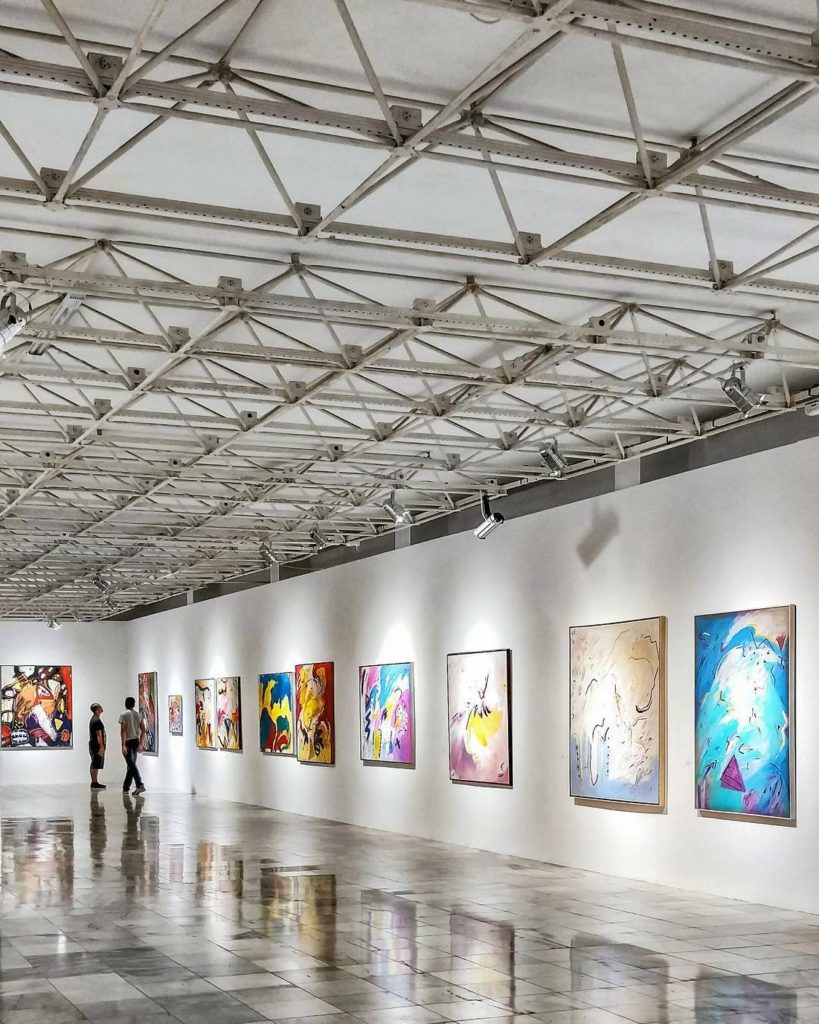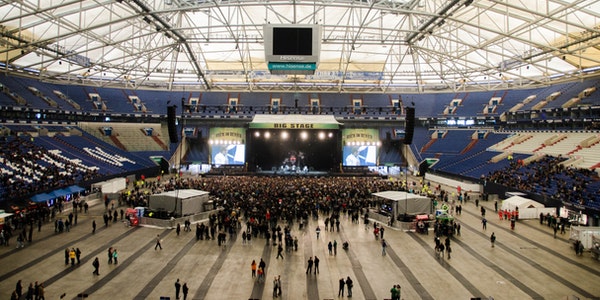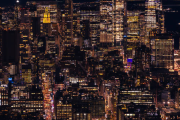Related standards
- According to “Architectural Lighting Design Standard” GB50034 2013, the standard values of illuminance for exhibition buildings are as follows:
| Room or place |
Reference plane and its height |
Standard value of illuminance(Lux) |
UGR | U0 | Ra |
| Meeting room |
0.75 meters horizontal |
300 |
19 |
0.6 | 80 |
| Ballroom |
0.75 meters horizontal |
300 |
22 |
0.6 | 80 |
| Multi-Function Room |
0.75 meters horizontal |
300 |
22 |
0.6 | 80 |
| Public hall |
ground |
200 |
22 |
0.4 | 80 |
| General exhibition hall |
ground |
200 |
22 |
0.6 | 80 |
| High-end showroom |
ground |
300 |
22 |
0.6 | 80 |
- According to “Code for Electrical Design of Convention and Exhibition Buildings” JGJ333-2014, the standard values of illuminance in common rooms or places of exhibition buildings are as follows:
| Room or place |
Reference plane and its height |
Standard value of illuminance(Lux) |
UGR |
Ra |
|
|
Exhibition hall |
General exhibition hall |
ground |
200 |
22 |
80 |
|
High-end showroom |
ground |
300 |
22 |
80 | |
|
Landing hall, |
ground |
200 |
22 |
80 |
|
|
Meeting room |
0.75 meters horizontal |
300 |
19 |
80 | |
|
Video conference room |
0.75 meters horizontal |
750 |
22 |
80 |
|
|
Multi-Function Room, Ballroom |
0.75 meters horizontal |
300 |
22 |
80 |
|
|
Information desk |
0.75 meters horizontal |
200 |
/ |
80 |
|
Design requirements
1. Types of lighting
General lighting, local lighting, emergency lighting and duty lighting
2. Lighting quality requirements
1) The wall-mounted exhibits have a surface brightness of 25cd/m2, and the surface illumination of the exhibits maintains a certain uniformity. Generally, the ratio of the lowest illuminance to the highest illuminance should be greater than 0.75.
2) For wall-mounted exhibits with gloss or glass frame, the position of the lighting source should avoid the reflection interference area to reduce reflected glare. In order to prevent the effect of the mirror surface, the ratio of the brightness of the audience facing the direction of the exhibit to the brightness of the surface of the exhibit should be less than 0.5.
3) For three-dimensional exhibits, a directional spotlight should be set at 40°~60° in front of the side of the exhibit. The illuminance is 3~5 times the general illuminance. When the exhibit is dark, it is 5~10 times.
4) For display cabinet lighting, attention should be paid to the configuration of lighting fixtures and shading boards to prevent direct glare.
Lighting Electrical Design
1. Lighting power supply and distribution design
1.1 The general lighting in the exhibition area is a secondary load. When conditions permit,
the two power sources each have 50% lighting fixtures for power supply. The standby lighting
of the exhibition hall should be determined according to the level of the exhibition hall. The standby
lighting of the first-class and second-level exhibition halls is the first-level load, and the
standby lighting of the C-level exhibition hall is the second-level load.
1.2 The standby lighting of the exhibition hall is set up to increase the best effect of the exhibits.
One power supply can be used for power distribution, and there can be an on-site power
distribution box for the booth.
1.3 On-duty lighting can be considered as part of normal lighting.
1.4 The power supply for the lighting of the collection warehouse and exhibition hall should be equipped with fire protection and residual current action protection devices.
2. Lighting Control Method
2.1 The exhibition hall lighting should adopt a photoelectric control automatic dimming control system,
which automatically controls or adjusts the intensity of the lighting according to the change of natural light,
and maintains the stability of the illuminance in order to save energy.
2.2 The exhibition building is a crowded place, and the lighting control switch serving the exhibition hall
should be divided into centralized and individual control management.
2.3 Panel centralized control can be used when there are few power distribution circuits, and intelligent
lighting control system should be used when there are many power distribution circuits, which is
convenient for management and prevents misoperation in public lighting areas.
2.4 The intelligent lighting control system should consider not only the centralized control and management,
but also the on-site controller to work independently from the host when the system fails.
2.5 The controller should be able to accept emergency signals, and automatically switch to execute emergency commands after receiving the signals.
2.6 The lighting control needs of the district lighting, such as duty, cleaning, exhibition arrangement and
exhibition should be considered.
2.7 The power switch of the collection warehouse should be uniformly set outside the main door of the collection warehouse in the warehouse area, and the lighting of the collection warehouse should be controlled in different areas.
3. Line laying
3.1 The wiring should be laid along the metal trough box and along the wall to the space above the exhibition hall.
3.2 The lighting circuit and emergency lighting circuit should be laid in separate slots.
3.3 Flame-retardant cables can be used when laying general lighting lines with trunking, and fire-resistant cables should be used when laying trunks for emergency lighting lines.
3.4 The lighting circuit of the collection warehouse and exhibition hall should adopt copper core insulated
wire dark wiring method.
4. Overhaul and maintenance of lamps
4.1 The horse track should be used for maintenance of lamps and lanterns. The horse track should be
arranged along the lamps according to the characteristics of the exhibition hall. When the metal grid frame
is used, it should be set regularly in accordance with the shape of the grid frame.
4.2 When using a lift to overhaul lamps, the daily storage location of the lift needs to be considered.
4.3 Intelligent electric lifting lamps can be used.
Intelligent Lighting System Solutions for Exhibition Centers
The technology of the intelligent lighting control system is constantly updated with the development of modern building technology to adapt to the layout of various building structures, the selection of different lamps and lanterns, to achieve diversified control modes. Since this is an open system, standard interfaces can be used to connect with other systems such as security, fire protection, etc. to complete the system integration function. At the same time, using the monitoring software equipped with the system, the building management staff can use the friendly control interface, which can be extremely convenient Remote control to monitor the working status of all equipment in the building.
The characteristics of modern high-rise exhibition center lighting
At present, various convention and exhibition center buildings are constantly emerging, whether it is work content, space, or the building itself, there are many different characteristics. The modern convention and exhibition center is a working environment composed of multiple visual effects. The comfort of the visual environment should be considered from the following aspects:
★Choose the right illuminance,
★Reduce direct glare and reflected glare of light source,
★Color rendering of interior decoration and light source,
★Reasonable distribution of indoor brightness,
★Design a good architectural space environment.
In many important occasions of the convention and exhibition center, lighting effects play a very important
role in the entire environment. Therefore, the lighting design is particularly important. Usually, a variety of light sources are used, which are stylish and rich. Through dimming and scene prediction The setting function creates a variety of lighting effects, transforms different light spaces, and gives people a comfortable and perfect visual enjoyment.
The lighting control system of a modern high-rise exhibition center building should have:
1) Through reasonable management to save energy and reduce operating costs, while facilitating operation and management, improving the level of building management,
2) Provide users with a comfortable working environment to ensure that staff have high work efficiency.
As an effective lighting control system, the above two aspects should be met.
Intelligent Lighting Control System Application Effect
1. Realize Intelligent Lighting Control
After adopting the Tachyon intelligent lighting control system, the lighting system can be operated in a fully automatic state. The system will switch several basic working states according to preset settings, usually “day”, “night”, “safe”, “clean”, “weekend” And “lunch”, etc., switch between various working states according to the preset time.
Whenever a working day is over, the system will automatically enter the “night” working state, and automatically dim the lights in each working area very slowly. At the same time, the system’s motion detection function will automatically start, so that the lights in the exhibition center without people will automatically turn off. On the contrary, motion detection can ensure that the lights in areas with staff are at the appropriate brightness.
The system can also coordinate the lights in public areas such as public walkways and stairwells. When there are employees working overtime in the exhibition center, the lights in public areas such as staircases and walkways will maintain the basic brightness. Adjust the light to the “safe” state or turn it off.
In addition, you can also use a manual control panel or remote control to change the illuminance of each area
at will.
For the reception halls, restaurants, meeting rooms, lounges and entertainment venues of the high-level
convention and exhibition center building, the lighting scene can be pre-set carefully according to different
times of the day and for different purposes. When using, you only need to call the preset best The lighting
scene makes guests produce novel visual effects.
2. Improve the working environment and increase work efficiency
In the convention and exhibition center of the building, equipped with dimmable LED lights under the control
of the intelligent lighting control system has significant advantages compared with the traditional fluorescent lighting system.
Because fluorescent tubes equipped with traditional ballasts flicker at a frequency of 100 Hz (twice the
frequency of the grid), this flickering makes the staff’s brains bloated and eyes tired, which reduces work efficiency. The dimmable LED lamp not only overcomes the stroboscopic light, but also eliminates the unstable brightness caused by the use of the starter, providing employees with a more healthy working environment and improving
work efficiency. But it brings unexpected huge economic returns to the owners.
3.Consistency of illuminance
When general lighting designers perform lighting design for a new exhibition center, the illuminance
is usually higher than the standard, usually 700lux, and the standard illuminance is 400lux. This is because the efficiency of the lamp and the reflectivity of the room wall continue to decrease over time. If the designer designs
in accordance with the standard illuminance in the early stage, it will not take long for the room illuminance to be lower than the standard requirements, and thus does not meet the illuminance requirements of the exhibition center. It is precisely because of the high illuminance design of this new room that not only causes the
inconsistency of the illuminance during the use period of the exhibition center, but also causes energy waste
due to the high illuminance.
Using the Tachyon intelligent lighting control system, because it can be intelligently dimmed, although the illuminance is still high design, the system will maintain a constant illuminance during the use period of the exhibition center according to the preset standard brightness, and is not affected by the reduction of lamp
efficiency and walls. The influence of surface reflection coefficient attenuation. This is another benefit that is
not easy to be noticed by people installing an intelligent lighting control system.





